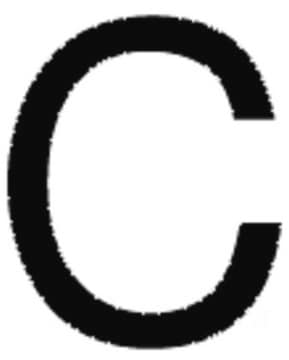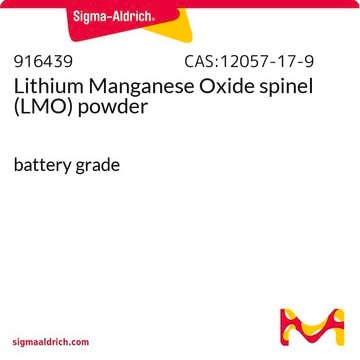934771
Lithium iron phosphate
electrode sheet, aluminum substrate, size 5 in. × 10 in.
Synonyme(s) :
LFP electrode
About This Item
Produits recommandés
Matériaux
aluminum substrate (current collector)
Niveau de qualité
Qualité
battery grade
Description
Capacity: >= 170 mAh/g
Description/Nominal Voltage: 3.2 V vs. Li/Li+
Pureté
≥98% (active material characteristic)
Composition
Active material loading 7.3 mg/cm2 ± 5%, ≥85%
Caractéristiques du produit alternatif plus écologique
Design for Energy Efficiency
Learn more about the Principles of Green Chemistry.
sustainability
Greener Alternative Product
Taille
16 μm , aluminum current collector
5 in. × 10 in.
Épaisseur
70 μm ± 5% , excluding current collector
Dimension de pores
~2 μm particle size (active material characteristic)
Capacité
≥170 mAh/g (Nominal)
Application(s)
battery manufacturing
Autre catégorie plus écologique
Catégories apparentées
Description générale
Application
Produit(s) apparenté(s)
Code de la classe de stockage
13 - Non Combustible Solids
Classe de danger pour l'eau (WGK)
WGK 3
Point d'éclair (°F)
Not applicable
Point d'éclair (°C)
Not applicable
Certificats d'analyse (COA)
Recherchez un Certificats d'analyse (COA) en saisissant le numéro de lot du produit. Les numéros de lot figurent sur l'étiquette du produit après les mots "Lot" ou "Batch".
Déjà en possession de ce produit ?
Retrouvez la documentation relative aux produits que vous avez récemment achetés dans la Bibliothèque de documents.
Notre équipe de scientifiques dispose d'une expérience dans tous les secteurs de la recherche, notamment en sciences de la vie, science des matériaux, synthèse chimique, chromatographie, analyse et dans de nombreux autres domaines..
Contacter notre Service technique








